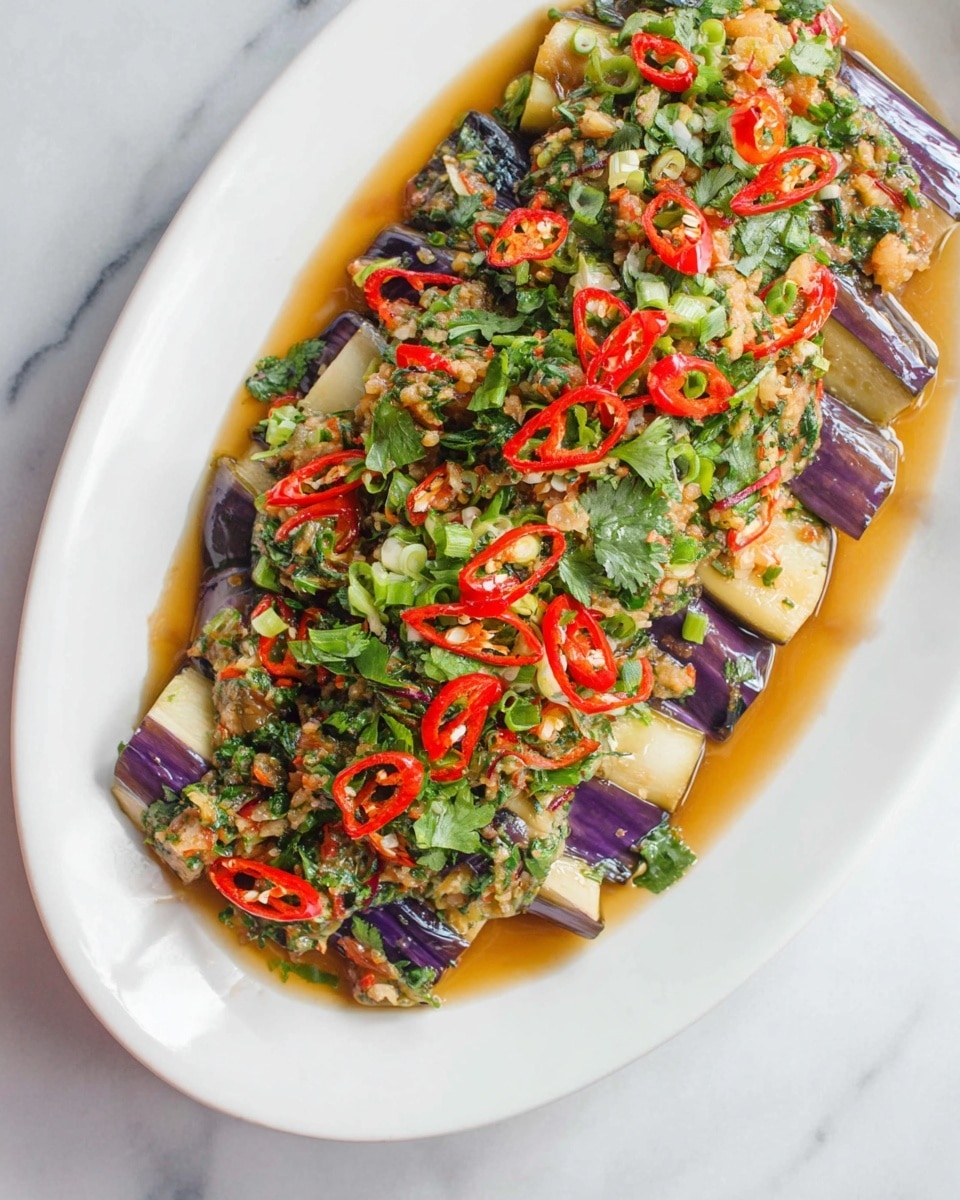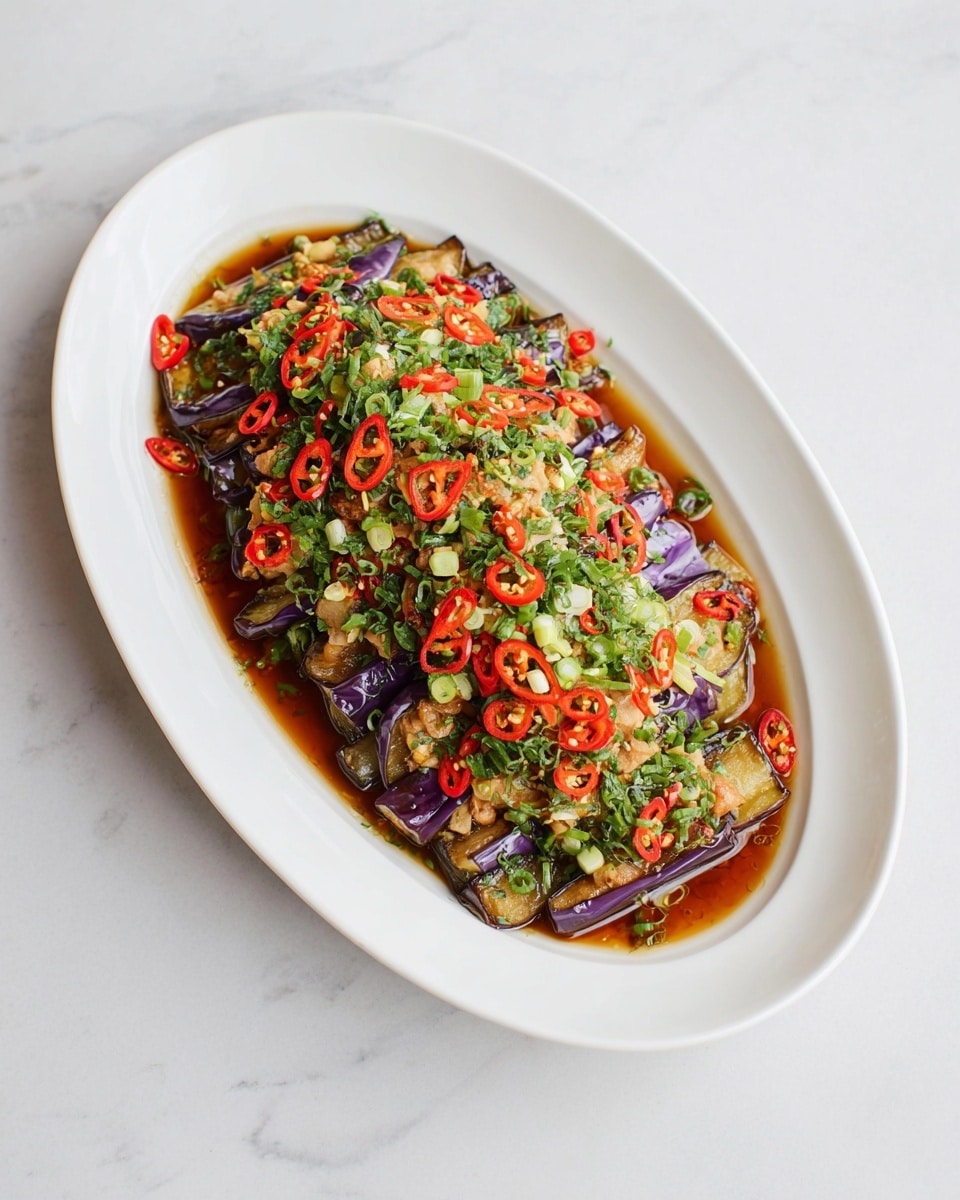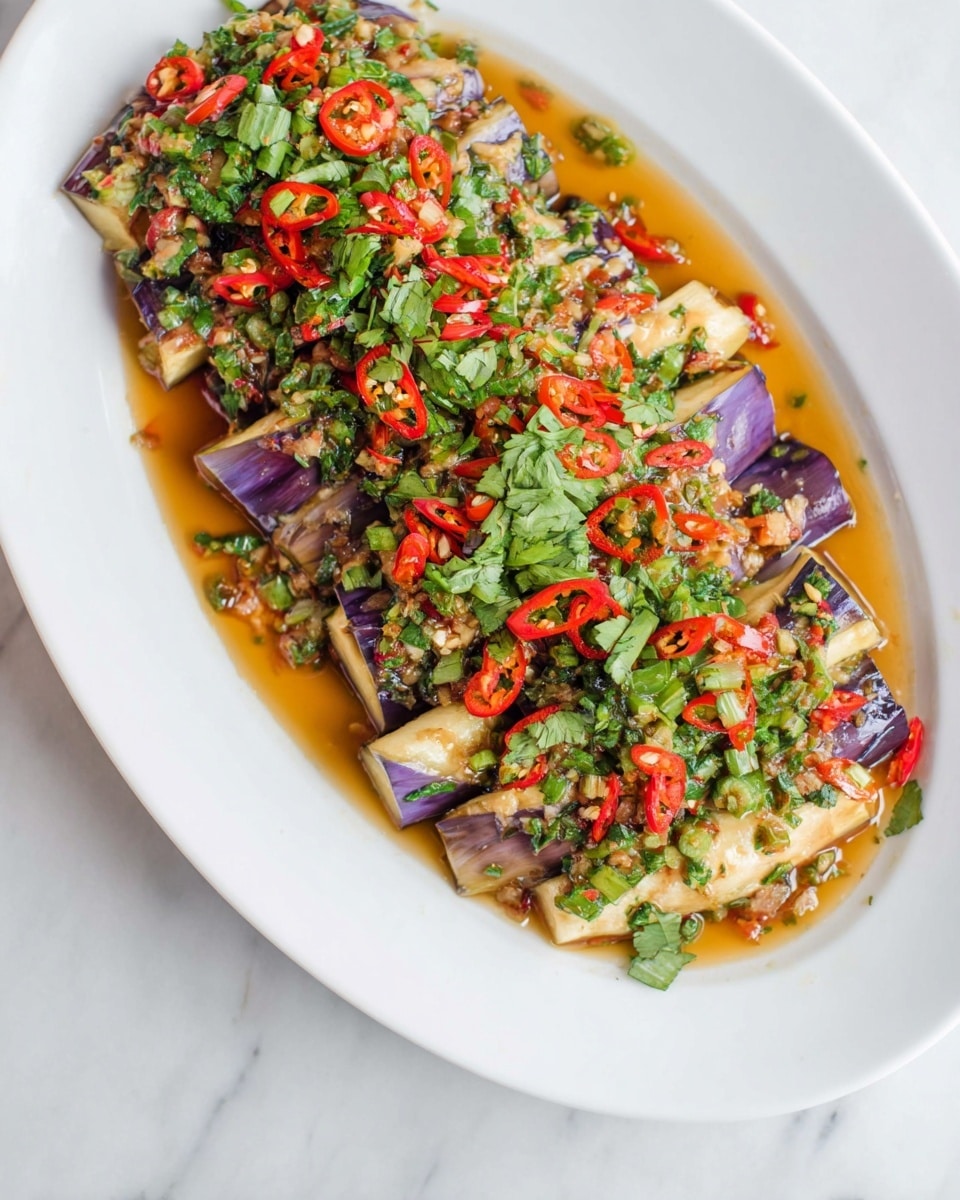If you’re curious about something light, refreshing, and bursting with umami, let me introduce you to my all-time favorite **Liang Ban Qie Zi (Chinese Steamed Eggplant Salad) Recipe**. It’s honestly one of those dishes that sneaks up on you—simple ingredients coming together to create something absolutely fan-freaking-tastic. When I first tried this, I couldn’t get over how tender the eggplants get, soaking in that garlicky, tangy sauce. Trust me, stick with me here and I promise you’ll have a new staple for your weeknight dinner line-up!
Why You’ll Love This Recipe
- Silky, melt-in-your-mouth texture: The steaming process transforms eggplant into the softest, most luscious bites you’ll love.
- Flavor-packed dressing: Garlic, ginger, soy, and black vinegar come together in a bright sauce that elevates every bite.
- Quick and fuss-free: You don’t need fancy tools—just a pan and plate to steam and a few pantry staples.
- Versatile and crowd-pleasing: It works great as a side or light main, perfect for hot days or when you want something fresh but satisfying.
Ingredients You’ll Need
Everything in this Liang Ban Qie Zi (Chinese Steamed Eggplant Salad) Recipe is simple and easy to find, yet they work beautifully together to create layers of flavor and texture. When buying eggplants, Chinese eggplants are ideal for their thin skin and mild taste, but if you can’t find them, Persian or globe eggplants will still do nicely.
- Chinese Eggplants: Thin-skinned and tender, they steam beautifully — but Persian or globe eggplants work if that’s what you have.
- Salt: Helps draw out bitterness and softens the eggplant; essential for that silky mouthfeel.
- Garlic: Gives the sauce a bold aromatic punch; fresh is best to keep it vibrant.
- Ginger: Adds a nice mild heat and freshness that balances the richness.
- Spring Onions: For crunch and that subtle onion flavor in the dressing.
- Long Red Chili: Adds a gentle kick and a pop of color; adjust to your heat preference.
- Vegetable Oil: Gets heated and poured over aromatics to release their flavors—you can use any neutral oil.
- Light Soy Sauce: The salty backbone to the dressing. Ensure it’s light (not dark soy) for a balanced flavor.
- Black Vinegar (Chinkiang): This adds tang and depth—if you can’t find it, a mix of balsamic and rice vinegar is a decent stand-in.
- Toasted Sesame Oil: Just a little for that nutty aroma and flavor finish.
- Golden Caster Sugar: Balances out the acidity and saltiness in the dressing.
- Coriander: Fresh and bright, it’s the finishing touch that brings everything alive.
Variations
I love how flexible this Liang Ban Qie Zi (Chinese Steamed Eggplant Salad) Recipe is—you can easily make little tweaks to suit your mood, diet, or what’s in season. Don’t be afraid to try your own twists and tailor the heat level or herbs to your liking.
- Mild Version: I sometimes skip the chili for a kid-friendly version that still packs plenty of flavor.
- Extra Crunch: Add toasted peanuts or sesame seeds on top if you want an extra layer of texture.
- Herb Swap: Cilantro isn’t your jam? Fresh mint or Thai basil make interesting alternatives that I’ve enjoyed.
- Make It Vegan: This recipe is naturally vegan, but keep an eye on soy sauce (some brands contain wheat)—choose gluten-free tamari if needed.
How to Make Liang Ban Qie Zi (Chinese Steamed Eggplant Salad) Recipe
Step 1: Soak and Prepare the Eggplants for Steaming
Start by trimming your eggplants and cutting them into 8cm chunks—if you’re using globe eggplants, cut these chunks lengthwise into smaller pieces so they cook evenly. Then, fill a large bowl with 1 liter of water and stir in 1 tablespoon of salt. Pop the eggplant pieces in, weigh them down with a plate so they stay submerged, and soak for 10 minutes. This step is key—trust me, it helps draw out bitterness and ensures that perfect tender texture after steaming.
Step 2: Set Up Your Steaming Station
If you don’t have a fancy steaming basket, no worries—I use a little trick. Place a small heat-proof bowl or dish inside a wide pan, add boiling water so it’s just a couple of centimeters deep, making sure it doesn’t touch the plate resting on the bowl. Cover and bring the water to a rapid boil. Drain your eggplants, arrange them on the plate (stacking is fine), putting firmer pieces that were closer to the stem on top—they take a bit longer to cook. Cover the lid and let them steam gently over medium-low heat for 5 to 10 minutes, depending on your stove and eggplant size, until knife-tender. This technique gives you super even, soft eggplants every time.
Step 3: Whip Up the Aromatic Sauce
While the eggplants cool, finely chop your garlic and ginger, thinly slice the spring onions and red chili, then combine everything in a small bowl. Heat the vegetable oil until it’s just smoking hot, and pour it over the aromatics—this step wakes up all the flavors and gives the sauce that beautiful depth. Add the soy sauce, black vinegar, toasted sesame oil, and caster sugar right after, then stir nicely to blend all those layers together. Make sure your sugar fully dissolves; it adds balance that really makes this dish stand out.
Step 4: Tear, Arrange, and Dress Your Eggplants
When the eggplants are cool enough to handle (cooling is important so they don’t get mushy when mixed), tear each chunk in half lengthwise and then into 3-4 long strips—or leave globe eggplants as they are if you prefer chunkier pieces. Arrange them thoughtfully on a serving platter; I like to spread them out so the sauce can soak in properly. Pour your aromatic dressing over the top, scatter chopped fresh coriander to garnish, and you’re ready to dig in!
Pro Tips for Making Liang Ban Qie Zi (Chinese Steamed Eggplant Salad) Recipe
- Soaking Sweetness: I always soak the eggplant in salted water first—it takes the bitterness out and makes the texture silky smooth.
- Temperature Matters: Pouring hot oil over the aromatics is a game-changer—it unlocks intense flavor and aroma that you can’t get with cold sauce.
- Don’t Oversteam: Keep an eye—eggplants cook quickly, and oversteaming can turn them mushy, so test with a knife around 5 minutes in.
- Chop Timing: Wait until the eggplant cools before tearing; this helps keep the texture intact and doesn’t turn it into a purée.
How to Serve Liang Ban Qie Zi (Chinese Steamed Eggplant Salad) Recipe

Garnishes
I always top Liang Ban Qie Zi with fresh coriander because it adds such a bright, herbal lift that perfectly complements the umami-rich eggplant. Sometimes I’ll sprinkle toasted sesame seeds or even chopped roasted peanuts for a little crunch and nuttiness—my family goes crazy for that contrast!
Side Dishes
This salad pairs beautifully with steamed white rice and some simply stir-fried greens like bok choy or gai lan. On busy nights, I’ve even served it alongside some pan-fried dumplings or grilled tofu for a more substantial meal. It’s versatile, so you can customize based on what you have on hand.
Creative Ways to Present
For dinner parties, I like to present the eggplant salad in shallow, individual bowls and garnish each plate with a chili ring and a sprig of coriander for a classy look. Sometimes, serving it chilled with a side of cold noodles or wrapped in thin rice paper rolls makes for a fresh and fun twist that guests rave about.
Make Ahead and Storage
Storing Leftovers
I find this salad actually tastes better the next day after the flavors have melded together. Store leftovers in an airtight container in the fridge for up to 2 days. Just remember that the eggplants may release some water, so give it a gentle stir to redistribute the sauce before serving.
Freezing
Freezing steamed eggplant salads is a bit tricky since the texture gets mushy when thawed. I usually don’t freeze this dish, preferring to enjoy it fresh or refrigerated. If you must, make sure to freeze in a tight container and expect some textural softening.
Reheating
If you want to warm it up, I recommend gently heating the eggplants in a steamer or microwave for a short time—overheating can soften them too much. You could also enjoy the salad cold or at room temperature, which preserves the texture and flavors beautifully.
FAQs
-
Can I use regular eggplants instead of Chinese eggplants for this recipe?
Absolutely! While Chinese eggplants have thinner skin and a milder taste, Persian or globe eggplants can be used too. Just cut them into smaller, thinner pieces so they cook evenly and tenderize well during steaming.
-
Do I need a special steamer to make Liang Ban Qie Zi?
Nope! If you don’t have a steaming basket, you can easily improvise with a heat-proof bowl and plate on top inside a large pot or pan with a lid. Just be sure the boiling water doesn’t touch the plate. This trick works great and is how I often steam at home.
-
What’s the purpose of pouring hot oil over the garlic and ginger?
Pouring hot oil over aromatics like garlic, ginger, and spring onions “blooms” their flavors, releasing essential oils and softening their bite. It creates a fragrant, deeply flavorful sauce that’s key to the salad’s signature taste.
-
Can I make this salad ahead of time?
Yes! It actually tastes even better after a few hours or overnight because the flavors meld beautifully. Just keep it refrigerated and stir gently before serving to recombine any separated juices.
-
Is Liang Ban Qie Zi suitable for vegan diets?
Definitely! This salad contains no animal products, so it’s naturally vegan. Just double-check that your soy sauce is vegan, as some brands use additives or fermentation agents you might want to avoid.
Final Thoughts
I absolutely love how this Liang Ban Qie Zi (Chinese Steamed Eggplant Salad) Recipe manages to be so simple yet packed full of flavor and texture. It’s the kind of dish that feels like a warm hug from Chinese home cooking—perfect for those days when you want something light but satisfying. I’ve been making this for years, and honestly, it never fails to impress family and friends alike. So go ahead, give this recipe a try—I promise it’ll become one of your trusty go-to dishes too.
Print
Liang Ban Qie Zi (Chinese Steamed Eggplant Salad) Recipe
- Prep Time: 30 minutes
- Cook Time: 10 minutes
- Total Time: 40 minutes
- Yield: 2 servings
- Category: Salad
- Method: Steaming
- Cuisine: Chinese
- Diet: Vegetarian
Description
Liang Ban Qie Zi, also known as Chinese Steamed Eggplant Salad, is a flavorful and light dish featuring tender steamed Chinese eggplants dressed in a vibrant sauce of garlic, ginger, soy, vinegar, and sesame oil. This home-style classic is easy to prepare and perfect as a refreshing side dish or appetizer, offering a delightful blend of silky textures and tangy, savory notes.
Ingredients
Eggplant
- 2 Chinese eggplants (400g), or Persian or globe eggplants
- 1 tbsp salt
Dressing
- 2 large garlic cloves
- 10 g ginger
- 2 spring onions
- 1 long red chilli
- 2 tbsp vegetable oil
- 2 tbsp light soy sauce
- 1 tbsp black vinegar (Chinkiang vinegar)
- 1 tsp toasted sesame oil
- 1 tsp golden caster sugar
- 10 g coriander
Instructions
- Prepare Eggplants: Trim the eggplants and cut them into 8cm long chunks. For globe eggplants, cut lengthwise into eight pieces. In a large bowl, dissolve 1 tablespoon salt in 1 liter of water, add the cut eggplants, weigh them down with a plate, and soak for 10 minutes to remove bitterness.
- Set Up Steaming: If you do not have a steaming basket, place a small heat-proof bowl in a wide pan with a lid and rest a ceramic heat-proof plate on top. Pour boiling water from a kettle into the pan to a depth of a few centimeters, ensuring the water does not touch the plate, then bring the water to a rapid boil over medium-high heat.
- Steam Eggplants: Drain the soaked eggplant pieces and arrange them on the plate. It’s okay to stack the pieces, placing the stem-end pieces on top as they are firmer and require longer cooking. Cover the pan with the lid and steam the eggplants over medium-low heat for 5-10 minutes, or until knife tender.
- Prepare Dressing: While the eggplant cools, peel and finely chop garlic and ginger. Thinly slice the spring onions and red chili. Place all aromatics into a small bowl. Heat the vegetable oil until it just begins to smoke and pour it over the aromatics. Stir in the light soy sauce, black vinegar, toasted sesame oil, and golden caster sugar until well combined.
- Finish and Serve: Once cooled enough to handle, tear each eggplant piece in half lengthwise, then halve each half into 3-4 long strips (for globe eggplant, leave as they are). Arrange the eggplant on a serving platter, pour the prepared sauce evenly over the top, garnish with roughly chopped coriander, and serve immediately.
Notes
- Liang Ban Qie Zi is a classic Chinese home-style dish that highlights the silkiness of steamed eggplant paired with a tangy and savory dressing.
- Using Chinese eggplants is preferred for their tender texture but Persian or globe eggplants can be substituted with slight adjustments in cutting.
- Soaking eggplant in salted water helps reduce bitterness and improve texture.
- The hot oil poured over aromatics in the dressing releases their flavors, creating an aromatic punch.
- This dish is best served warm or at room temperature and is ideal for light summer meals.
- For a spicier version, increase the amount of red chili or add chili oil to the dressing.
Nutrition
- Serving Size: 1 serving
- Calories: 120 kcal
- Sugar: 4 g
- Sodium: 800 mg
- Fat: 7 g
- Saturated Fat: 1 g
- Unsaturated Fat: 6 g
- Trans Fat: 0 g
- Carbohydrates: 12 g
- Fiber: 4 g
- Protein: 2 g
- Cholesterol: 0 mg









